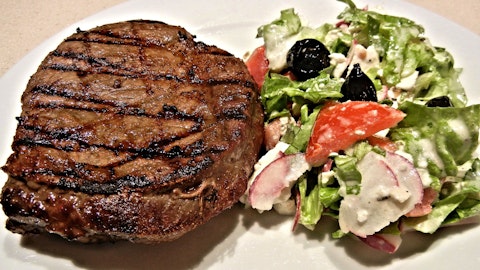Tyson Foods, Inc. (NYSE:TSN) Q1 2023 Earnings Call Transcript February 6, 2023
Operator: Good morning and welcome to the Tyson Foods First Quarter 2023 Earnings Conference Call. Please note today’s event is being recorded. I would now like to turn the conference over to Sean Cornett, Vice President, Investor Relations. Please go ahead, sir.
Sean Cornett: Good morning and welcome to Tyson Foods’ fiscal first quarter 2023 earnings conference call. Prepared remarks today will be provided by Donnie King, President and Chief Executive Officer and John R. Tyson, Executive Vice President and Chief Financial Officer. Additionally, Brady Stewart, Group President, Fresh Meats; Stewart Glendinning, Group President, Prepared Foods; Wes Morris, Group President, Poultry; and Amy Tu, President, International and Chief Administrative Officer, will join the live Q&A session. We have prepared presentation slides to supplement our comments, which are available on the Investor Relations section of the Tyson website and through the link on our webcast. During today’s call, we will make forward-looking statements regarding our expectations for the future.
These forward-looking statements made during this call are provided pursuant to the Safe Harbor provisions of the Private Securities Litigation Reform Act of 1995. Forward-looking statements include comments reflecting our expectations, assumptions or beliefs about future events or performance that do not relate solely to historical periods. These forward-looking statements are subject to risks, uncertainties and assumptions, which may cause actual results to differ materially from our current projections. Please refer to our forward-looking statements disclaimers on Slide 2 as well as our SEC filings for additional information concerning risk factors that could cause our actual results to differ materially from our projections. We assume no obligation to update any forward-looking statements.
Please note that references to earnings per share, operating income and operating margin in our remarks are on an adjusted basis unless otherwise noted. For reconciliations of these non-GAAP measures to their corresponding GAAP measures, please refer to our earnings press release. Now, I will turn the call over to Donnie.
Donnie King: Thank you, Sean and thank you to everyone on the call for joining. Earlier today, we announced our first quarter 2023 results. We delivered solid top line results with year-over-year revenue and volume growth and continued strength in our share position, providing momentum for the remainder of the fiscal year. Compared to record performance in the prior year, first quarter earnings declined driven by weaker results in chicken, pork and beef, which more than offset strong performance in Prepared Foods. It’s important for you to know that we are uniquely positioned to win in an attractive global protein market. We have market leading brands across diverse portfolio that resonate with consumers as proven by our year-over-year sales and volume growth.
We serve an estimated one-fifth of U. S. protein consumption and we are well positioned to meet consumer demand, which remains steady despite a challenging macroeconomic environment with ongoing elevated levels of inflation. As we navigate a complex and dynamic operating environment, I am grateful for our team members whose hard work and dedication make our business operations possible. Five key pillars of our strategy are: transforming our team member experience, growing with our customers to service demand, investing in digital and automation to drive operational excellence, restoring competitiveness in our Chicken segment and leveraging our financial strength to invest in the business and return cash to shareholders. In service of these long-term strategic imperatives, I’d like to emphasize that we continue to deliver on our commitments of growing volume by filling up our footprint, solving labor problems, investing in automation, and building inventory to meet customer demand with improved fill rates all while maintaining a focus on liquidity and financial health.
We are confident these investments will pay dividends over the long run and we remain committed to methodically executing our growth strategy driving long-term value creation for our shareholders. Now, let me take a moment to discuss our results and shed some light on some of the challenges and outlook. We went into Q1 with a good plan, but our overall results were impacted by a confluence of factors, including consumer and customer demand dynamics and the curve of the beef cycle, among other things. Allow me to touch on each segment. As we have previously mentioned to you, we have been expecting beef to come under pressure for some time. With higher cattle prices, we expected overall harvest to slow down, but that hasn’t happened yet. As such, we continue to draw on the herd, which continues to decline.
This is putting pressure on spread margin in the business. We tightened our outlook range for the year. For pork, when you account for mark-to-market derivatives in the number, we flip back to breakeven as expected, but given continued supply and demand dynamics, we lowered our outlook for the year by 200 basis points. For chicken, when compared to expectations from last quarter, a few different things didn’t go as planned. Most notably, demand didn’t appear in the parts of the market where we had expected. As a result, we had to move things around and we experienced higher cost, a lower price environment and knock-on effects from a network standpoint. And last, it’s worth emphasizing our Prepared Foods segment, which delivered a great result for the quarter.
We said we were going to grow dollar share and volume share with the strongest portfolio of brands in the categories where we compete and we have done just that. We are feeling good about the outlook for the balance of the year. And our international business continues to build momentum in terms of volume and sales growth. With the end of COVID lockdowns, particularly in China, we expect good year-over-year comps. We will dive deeper into this during the discussion of segment results and the Q&A portion of the call. Now, let’s turn to our growth numbers. Sales improved 2.5% year-over-year. And as we delivered record first quarter revenue for a total company and individually in chicken, Prepared Foods and International Other, we are focused on driving growth in these segments, which will enhance our margin profile over time.
We continue to see benefits of our efforts to optimize our existing footprint, add new capacity, adjust our product mix by plant, and match our portfolio more closely with customer and consumer needs. Prepared Foods revenues increased 8.8% for the quarter driven by both volume growth and pricing actions implemented in the prior year. Positive momentum continues to build in Prepared Foods, as it delivered sequential quarterly improvement in revenue since the fiscal fourth quarter of 2021, driven primarily by the strength of our retail brands. Beef revenue was down 5.6% compared to prior year. Lower average sales price driven by the decreased value of beef cut out more than offset the increased volume from higher headcount throughput. Compared to prior year, pork revenue was down 6% for the quarter.
This was driven by decreased volume due to balancing supply with customer demand, partly offset by increase in average sales price. Chicken revenue increased 9.6% compared to prior year driven by volume growth from increased domestic production and pricing initiatives and an elevated inflationary cost environment. In international, revenue growth remained strong, up 11.3% compared to prior year quarter. This was driven by our investment in capacity, innovation and brand to support market share growth. In the next few slides, we will detail our success winning in retail marketplace with our advantaged brands in advantaged categories. The retail categories in which we participate are highly consumer relevant with the vast majority remaining elevated relative to pre-pandemic and demonstrating growth over the prior year.
With our iconic retail brands, Tyson, Jimmy Dean, Hillshire Farm, and BallPark, Tyson core business lines outpaced total food and beverage and our peers in volume growth, up 9% relative to a year ago per Nielsen. Tyson core business lines also grew pound share by 2 points this quarter relative to year ago for Nielsen, continued to be market share leader in most of the retail core categories in which we compete. We delivered both dollar and pound share growth in both the aggregate and across day parts compared to a year ago, most notably in the morning meal occasion. Our brands continue to perform well as we see elasticities below historical levels. Additionally, Tyson, Jimmy Dean, Hillshire Farm, and BallPark, all hold favorite brand status with consumers in the categories in which we compete, highlighting our brand strength relative to our peers.
Consumers spend on relevant categories and brands they know and trust. The trajectory of our Tyson Core business lines volume share growth shows, the recovery we have seen since April and the momentum we now have. We have improved fill rates and on-shelf availability. Price gaps relative to competitors have narrowed while we continue to invest in merchandising and advertising to support our brands. These factors, along with other strong business fundamentals, resulted in sequential quarterly share growth in Tyson core business lines commanding a 5-year record high market share of nearly 28%. It is evident we are delivering the brands and products that consumers desire. While the foodservice industry is yet to recover to pre-pandemic traffic levels, the Tyson Focus 6 group is outperforming pre-pandemic volume sales, up 2.7 and 1.7 share points in the latest 52 weeks according to NPD SupplyTrack data.
The Tyson Focus 6 group is also outpacing both total broadline and its respective categories, up 11.7% in volume sales and 0.6 share points in the latest 52 weeks compared to last year per NPD. We believe strongly in our foodservice portfolio and are confident in the path to continue to grow this business as we align with key growing customers to build momentum for the future. Our team members are essential to providing the products our customers and consumers’ demand. We are seeing business results from making significant investments to become the most sought after place to work by investing in our team members’ experience. Recent highlights include expanding access to benefits with Day 1 eligibility, enhanced parental leave policies, expanding mental health benefits and citizenship support at no cost to our U.S. team members.
In November, as recognition for our Tyson immigration program’s commitment to improving the lives of immigrant team members, we received the prestigious Keepers of the American Dream award from the National Immigration Forum. We also just completed what we have been calling Project Next Frontier. We are setting the foundation for an HR shared service model focused on process and system efficacy and better overall HR service delivery for our team members, setting us up for savings in the future. I am pleased to report we are also progressing as expected with our North American headquarters consolidation focused on building our OneTyson culture. In addition to realizing savings, we are collaborating, innovating and working with greater speed and agility to serve our customers.
I would also like to thank our team members for their dedication that led to Tyson Foods number one ranking on Fortune Magazine’s list of the world’s most admired companies in food production category for the seventh consecutive year. Following the strong outperformance of expectation in fiscal 2022, the productivity program is on track to meet expectations this fiscal year and to deliver the $1 billion of recurring savings commitment a year earlier than originally promised. We expect this program to translate from a onetime initiative to sustained year-on-year productivity improvements, supporting our bottom line on a continued basis. Examples of initiatives in our productivity program include leveraging data analytics to improve inventory visibility, mitigating distressed pounds, a direct plant shipment program, which continues to bring on new customers and categories, removing miles from the roads and driving efficiency in our distribution network.
This is an example of how our scale drives competitive advantage. Investing heavily in automation, we recently rolled out automated sandwich hand wrap and burrito assembly capabilities as well as an automated line to serve snacking production. We have also continued to scale our chicken debone automation across multiple facilities and we are piloting a robotic tray pack machine that is showing promising results, expanding our smart factory program to digitize our plants to new sites as well as exploring opportunities to digitize our processes. Our progress displays how Tyson remains focused on optimizing our business processes, digitalizing the supply chain increasing automation and aggressively managing SG&A across our operations. Before I turn the call over to John to walk us through more detail on our financial results for the quarter some final comments.
Our segments individually and in aggregate have clear and compelling roles within Tyson’s portfolio strategy to deliver sustainable, high-quality growth at good value. We have a powerful and diverse portfolio across proteins and channels around the world. We have products for consumers across proteins and price points, delivering performance that supports the company’s long-term earnings objectives and desirable return for shareholders. We are modernizing our operations with our productivity program and are building a team positioned to take advantage of the opportunities in front of us. Again, we entered Q1 with a good plan to execute our strategy. That led to solid top line growth and strong performance in Prepared Foods. Market dynamics and some operational inefficiencies impacted our profitability.
We see opportunities to become more agile and efficient, which will further improve our operational execution. We remain committed to executing our growth strategy and are confident we will grow volume, revenue and operating income in the back half of fiscal year 2023 and have a long runway of growth ahead of us. With that, I will turn the call over to John.
John Tyson: Thanks, Donnie. First, let’s review a summary of our total company financial performance then we can dive deeper into the detail for the individual segments. As Donnie stated, sales were up year-over-year for the first quarter, benefiting from both volume growth and disciplined revenue management to offset elevated inflationary increases in our cost of goods. Looking at our sales results by channel, retail drove $324 million of top line improvement led by Chicken and Prepared Foods. Our industrial and other channel sales increased by $108 million, led by beef and chicken and this was offset by slight decreases in sales to the foodservice and international channels. As expected, given the record strength of beef a year ago, we delivered lower adjusted operating income in the prior year of $453 million.
This translated to an adjusted earnings per share of $0.85. Now, turning to the adjusted operating income bridge, we significantly grew Prepared Foods earnings in the quarter, but underperformance in chicken, pork and beef led to $979 million lower operating income compared to the prior year. While pricing actions led to an improvement of $222 million, higher input costs per pound increased cost of goods sold by $1.3 billion. About two-thirds of this increase was driven by inflationary impacts on raw material and supply chain costs. The remainder was primarily due to a shift to producing more value-added mix, higher labor costs and unfavorable derivative impact. Excluding the impact of restructuring, SG&A expenses as a percentage of sales was down to 3.7% from 4.3% in the prior fiscal year as we continue to eliminate non-value-added spend across our business while investing to support the future growth of our brands.

Photo by Jay Wennington on Unsplash
Our productivity program continues to play a critical role in the long-term improvement of our margin profile. Now to the individual segment results. Starting with the Beef segment, sales in the quarter remained strong at more than $4.7 billion, but were down 5.6% compared to record high sales in the prior year. Volume gains of 2.9% were supported by improved staffing for higher throughput, while the average sales price was down 8.5% due to softer domestic demand for Beef. Live cattle costs increased approximately $530 million in the quarter as cattle supplies continue to tighten. Net-net, segment operating income for beef was $129 million for an operating margin of 2.7% off the previous year’s historical record first quarter margin of 19%.
We saw higher cattle prices as beef herd numbers continue to decline. We will continue to monitor the beef cutout value and balance our supply with customer demand during a period of margin compression while pushing volume growth in case-ready and premium branded products. Although the near-term operating environment remains challenging, we have reasons to believe in our long-term outlook for beef. This outlook is supported by our investment in strategic supplier relationships that provide higher quality beef, a growing global demand, specifically in Asia, and the strengthening drop credit as well as opportunities to shift our beef products up the value pyramid. Now, let’s look at the Pork segment. Sales were approximately $1.5 billion for the quarter, down 6% for the record high in the prior year.
Average sales price gains of 1.4%, mostly driven by higher value specialty products were offset by volume decreases of 7.4%. International demand for U.S. pork products continues to be impacted by the strong U.S. dollar, while domestic demand is being affected by high retail prices despite the cutout realigning to historical norms. However, we are optimistic that when these factors normalize, demand will improve. We expect to see continued industry supply challenges in the fiscal year as the producer navigates herd health issues and higher input costs. On expenses, we incurred greater cost as lean hog costs increased approximately $55 million over the prior year. We also experienced an unfavorable year-over-year derivative impact of $35 million.
Segment operating income was lower than expected at a loss of $19 million for the quarter, down from a profit of $160 million in the prior year. As we move forward, pork margins should be supported over time with the normalization and the strength of the U.S. dollar aiding future export demand, a strengthening drop credit and additional opportunity to shift pork products up the value pyramid, especially into our case-ready business. Now, let’s move on to the Chicken segment’s results. Sales were a record first quarter high at $4.3 billion, up 9.6% from the prior year. The sales increase was attributable to a 2.5% uptick in volume and 7.1% gain in pricing compared to the prior year quarter. Volume gains are due to a combination of strategic choices to maximize our capacity utilization and pursue an optimal mix strategy with products and customers.
Our pricing results while improved were lower than expected. We pegged this to a combination of factors that influence chicken prices, mostly related to total protein availability, notably chicken and beef. We anticipate these factors easing in the back half of 2023 as beef availability lessened and total poultry harvest normalizes, providing support for improvement in our chicken prices. The fall in commodity chicken prices driven by heightened protein supply in the market and seasonal demand weakness does not change our strategy. Based on current USDA industry placement data, we are optimistic on our forward-looking supply conditions in the intermediate term. We intend to grow our domestic production to 42 million head per week during this fiscal year, which should enable us to improve our fixed cost leverage, grow volume and gain market share.
We will continue optimizing our plant network and portfolio mix to maximize the profitability of our Chicken segment, particularly by growing our portfolio of value-added products, which remain in high demand. Operating income in the quarter was negatively impacted by $225 million of higher feed ingredient costs and an unfavorable year-over-year derivative impact of approximately $40 million. Net-net, our Chicken segment delivered operating income of $77 million in the first quarter. We see significant room for improvement in the long-term operating margin of our Chicken segment as there is still work to do to attain industry leading performance and we are optimistic it can be achieved due to the following: our diversified value-added portfolio with lower margin volatility, our brand strength with the highest consumer awareness and brand loyalty according to Nielsen data, our growth strategy, taking advantage of existing capacity, optimization of our portfolio by shifting from commodity to value-added products, and last, a further implementation of our productivity program as we ramp up more automation.
Last, I want to turn to our Prepared Foods business. In this segment, we had a solid quarter with growth in both revenue and volume. This was driven by strong brands, increased support for our customers and pricing aimed at recovering the continued inflation. Revenue was approximately $2.5 billion for a record first quarter, up 8.8% compared to the prior year. Volume gains of 1.2% were driven by strength in retail, notably Jimmy Dean and improved customer fulfillment despite decreased volumes in foodservice. This quarter was our third sequential quarter of volume growth and we saw significant pricing power of our portfolio with a year-over-year increase of 7.6%. Driven by top line growth and productivity savings, we delivered segment operating income of $266 million for the quarter.
The operating margin of 10.5% was up from 8% in the prior year. We are very pleased with the performance of this quarter in Prepared Foods, as this segment is critical to drive profitable growth for Tyson by valuing of Beef, Pork and Chicken commodity meat products. We continue to be optimistic for the outlook of this segment due to the following. Our diversified portfolio meets consumers across meal eating occasions and snacking occasions in all sales channels. We are outperforming our competition in retail with room to grow further market household penetration. Our comprehensive foodservice portfolio has opportunity to grow by regaining lost customers and broadening our customer base. We have got additional operational efficiencies to unlock by increasing plant utilization in addition to the implementation of our various productivity initiatives.
And finally, we have an opportunity to innovate, expand and acquire into new spaces through new offerings, the growth of our existing products, and attractive disciplined approach to M&A. Now, turning to talk about our financial position. Building financial strength, investing in our business and returning cash to shareholders remain the priorities of our capital allocation strategy. We produced operating cash flows of $762 million for the quarter and our leverage ratio finished the quarter at 1.6x net debt to adjusted EBITDA, demonstrating our commitment to a sound balance sheet. Focused primarily on new capacity and automation objectives, we invested nearly $600 million into our business in the first quarter to capitalize on projected demand growth over the next decade.
Investment in the business, both organically and inorganically, is expected to generate returns at or above our 12% return on invested capital target over time. Our capital allocation priorities are first to invest in growth and productivity in our existing footprint. Then we will employ a disciplined M&A approach by investing in opportunities that fit well with our existing portfolio. Next, we remain focused on returning cash to shareholders through dividends and share repurchases. Notably, we will continue to support and grow the dividend for our shareholders as evidenced by its continuous payment since 1977 and annual increases each fiscal year since 2013. Our approach to share buybacks will continue to be managing for dilution and entering the market opportunistically when assessing for multiple factors.
We returned nearly $500 million in cash to shareholders in the quarter through $169 million in dividends and $313 million of share repurchases. At Tyson, we utilize a disciplined capital allocation approach to invest in our business for both organic and inorganic growth and we returned cash to shareholders while maintaining a robust balance sheet. Now, let’s turn to the fiscal 2023 financial outlook. We are maintaining our total company sales guidance of $55 million to $57 billion, which implies a 3% to 7% sales growth for the year. Supported by the factors detailed earlier, we expect future Beef segment margins to be in a normalized range of 5% to 7% in the long-term. However, based on current market dynamics, we now expect to perform between 2% and 4% this fiscal year.
Given the result in pork in the first quarter, we are lowering margin guidance for the year to be between 0% and 2%. Counter to normal seasonality for our pork segment, we expect the back half of the year to outperform the first half of the year. For our poultry business, we now expect full year margins to be between 2% and 4%, but gaining momentum through the year and exiting the fourth quarter at a margin above this range. Prepared Foods had a strong first quarter in performance as this is historically normal seasonality for the segment we are maintaining our expected full year margin performance to be between 8% and 10%. In international, we continue to see volume and sales growth year-over-year, and we anticipate improved profitability in fiscal 2023, driven by volume and revenue growth from new facilities ramping up.
We remain committed to growing our business internationally, representing the fastest-growing protein consumption markets in the world. Our expectation for CapEx for the remainder of the year is unchanged at approximately $2.5 billion. Our expectations for productivity savings remain unchanged at $300 million to $400 million. Our net interest expense and tax rate are now expected to be around $330 million and 24%, respectively. We remain committed to our investment-grade rating and managing our net leverage ratio to be at or below 2x net debt to adjusted EBITDA over the long-term, providing optionality for inorganic investment and additional return of cash to shareholders. In summary, we had a slower start than expected, but are optimistic on the outlook for the remainder of the fiscal year and long-term.
We have a great team, growing demand for our products, strong portfolio diversity and a differentiated asset footprint needed to win in the marketplace. Overall, we see some persistent market factors, some operational challenges, and some expected seasonality influencing our second quarter results. And therefore, we’re expecting total company volume, revenue and operating income to be meaningfully stronger in the second half of the year compared to the first half of the year. We remain in the strong financial position to support continued investment in our existing footprint, productivity and the support of our brands as we continue to grow our business and provide desirable returns for our shareholders. So with all that, I’ll turn the call back over to Sean for Q&A instructions.
Sean Cornett: Thanks, John. We will now move on to your questions. Please recall our cautions on forward-looking statements and non-GAAP measures apply to both our prepared remarks and the following Q&A. Operator, please provide the Q&A instruction.
See also Buffett Stock Portfolio: Recent Buys and 13 Best Value Dividend Stocks to Buy .
Q&A Session
Follow Tyson Foods Inc. (NYSE:TSN)
Follow Tyson Foods Inc. (NYSE:TSN)
Operator: Thank you. Today’s first question comes from Alexia Howard with Bernstein. Please go ahead.
Alexia Howard: Good morning, everyone.
Donnie King: Good morning.
John Tyson: Good morning.
Alexia Howard: Okay. I guess we need to focus in on the Chicken segment here. And I know in your prepared remarks, you made some comments about why things came up short this quarter. Can you talk about what was the big negative surprises, chicken prices? It sounds like there were some operational and executional issues. And also, as we look forward, can you talk about how quickly you expect some of those issues to resolve? And what gives you the confidence that they might improve over the remainder of the year? And then I have a follow-up.
Donnie King: Okay. Alexia, thank you and thank you for your question. I’ll start out with some broad comments, and we will get a little more tactical as it relates to chicken and then wait to your next question. But I would just simply tell you that Q1 was a very challenging quarter for us is the confluence of several external factors across all businesses. We saw market swings across all businesses and they were unpredictable and sizable. While we have opportunities to perform better and you would never hear me say anything other than that. This is the first time I’ve seen all markets work against us all at the same time. It’s the first time I remember market impacts being greater than those controllables that we have and the opportunity for improvement of them.
As we think about moving forward, efficiency in our operations and our company will be a focal point for us. There are some places where we need to make decisions faster and, in some cases, better decisions. In some cases, we will need to adjust our business model. And in other cases, the accuracy of our projections has to be better than what we’ve demonstrated here in Q1. I’d remind you and everyone else that we’re not bigger than the market. And in Q1 and over time, markets will do their job, and we simply have to do ours. Q2 will be seasonally softer than Q1, and the back half will be better than the first half. While the back half will be better than the first half, we feel good about our business outlook. For example, we knew the beef herd is nearing the bottom of the cycle.
We knew pork had heard health issues and that there would be incremental packing capacity coming online and it did. We did not expect the incremental beef, pork and chicken in the marketplace domestically in Q1, especially in light of the fact that the cost of animals and the cut out of the pricing was declining. Our Prepared Foods performed as expected, delivering on operating income. We grew share in both dollars and pounds in the quarter. And I would just I have to remind everyone else before I get into chicken in the details is that we have a strong diversified portfolio, and we have confidence in our multi-protein strategy that it will deliver growth and shareholder value. Now let me go a little deeper as it relates to chicken, and we perhaps can go even deeper or later.





